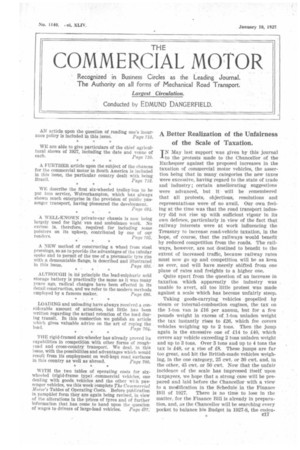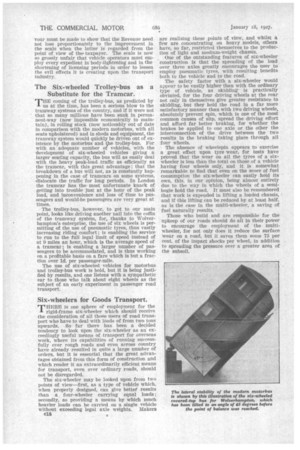A Better Realization of the Unfairness of the Seale of Taxation.
Page 39

Page 40

If you've noticed an error in this article please click here to report it so we can fix it.
IN May last support was given by this journal to the protests made to the Chancellor of the Exchequer against the proposed increases in the taxation of commercial motor vehicles, the assertion being that in many categories the new taxes were exce3sive, having regard to the state of trade and industry; certain ameliorating suggestions were advanced, but it will be remembered that all protests, objections, resolutions and representations were of no avail. Our own feeling at the time was that the road transport industry did not rise up with sufficient vigour in its own defence, particularly in view of the fact that railway interests were at work influencing the Treasury to increase road-vehicle taxation, in the hope, of course, that the railways would benefit by reduced competition from the roads. The railways, however, are not destined to benefit to the extent of increased traffic, because railway rates must now go up and competition will be as keen as ever, and will have merely shifted from one plane of rates and freights to a higher one.
Quite apart from the question of an increase in taxation which apparently the industry was unable to avert, all too little protest was made against a scale which has become unfairly steep.
Taking goods-carrying vehicles propelled by steam or internal-combustion engines, the tax on the 1-ton van is £10 per annum, but for a few pounds weight in excess of 1-ton unladen weight the tax instantly rises to £26, which fee covers vehicles weighing up to 2 tons. Then the jump again is the excessive one of £14 to £40, which covers any vehicle exceeding 2 tons unladen weight and up to 3 tons. Over 3 tons and up to 4 tons the tax is £48, or a rise of £8. These jumps are far too great, and hit the British-made vehicles weighing, in the one category, 25 cwt. or 30 cwt. and, in the other, 45 cwt. or 50 cwt. Now that the unfair incidence of the scale has impressed itself upon taxpayers, we hope that a strong case will be prepared and laid before the Chancellor with a view to a modification in the Schedule in the Finance Bill of 1927. There is no time to lose in the matter, for the Finance Bill is already in preparation, and, as the Chancellor will be searching every pocket to balance his Budget in 1927-8, the endea Your must be made to show that the Revenue need not lose proportionately to the improvement in the scale when the latter is regarded from the point of view of the taxpayer. The scale is now so grossly unfair that vehicle operators must employ every expedient in body-lightening and in the shortening of licensing periods in order to lessen the evil effects it is creating upon the transport industry.
The Six-wheeled Trolley-bus as a Substitute for the Tramcar.
THE coming of the trolley-bus, as predicted by us at the time, has been a serious blow to the tramway systems of the country, and if it were not that so many millions have been sunk in permanent-way (now impossible economically to maintain), in rolling stock (now noticeably out of date in comparison with the modern motorbus, with all seats upholstered) and in sheds and equipment, the tramway system would quickly be driven out of existence by the motorbus and the trolley-bus. For with an adequate number of vehicles, with the development of six-wheeled vehicles giving a larger seating capacity, the bus will as easily deal with the heavy peak-load traffic as efficiently as the tramcar, with this great advantage: that the breakdown of a bus will not, as is constantly happening in the case of tramcars on some systems, -dislocate the traffic for long periods. In London the tramcar has the most unfortunate knack of getting into trouble just at the hour of the peak load, and inconvenience and loss of time to passengers and would-be passengers are very great at times.
The trolley-bus, however, to get to our main point, looks like driving another nail into the coffin of the tramway system, for, thanks to Wolverhampton's enterprise, the use of six wheels is permitting of the use of pneumatic tyres, thus vastly increasing riding comfort; is enabling the service to run to the full legal limit of speed instead of at 9 miles an hour, which is the average speed of a tramcar; is enabling a larger number of passengers to be accommodated, and is thus working on a profitable basis on a fare which is but a fraction over id. per passenger-mile. The use of six-wheeled vehicles for motorbus and trolley-bus work Is bold, but it is being justified by results, and one listens with a sympathetic ear to those who talk about eight wheels as the subject of an early experiment in passenger road transport.
Six-wheelers for Goods Transport.
'THERE is one sphere of employment for the -11. rigid-frame six-wheeler which should receive the consideration of all those users of road transport who have to deal with loads of from two tons upwards. So far there has been a decided tendency to look upon the six-wheeler as an exceedingly useful means Of .transport for overseaswork, where its capabilities of running successfully over rough roads and even across country have already resulted in quite a large number of orders, but it is essential that the great advantages obtained from this form of construction and which render it an extraordinarily efficient means for transport, even over ordinary roads, should not be disregarded. The six-wheeler may be looked upon from two points of view—first, as a type of vehicle which, when properly designed, can give better results than a four-wheeler carrying equal loads ; secondly, as providing a means by which much heavier loads can be carried on a single vehicle without exceeding legal axle weights. Makers e18 • are realizing these points of view, and whilst a few are concentrating on heavy models, others have, so far, restricted themselves to the production of light and medium-weight chassis. One of the outstanding features of six-wheeler construction is that the spreading of the load over three axles greatly encourages the user to employ pneumatic tyres, with resulting benefits both to the vehicle and to the road, The safety factor with a six-wheeler would appear to be vastly higher than with the ordinary type of vehicle, as skidding is practically obviated, for the four driving wheels at the rear not only in themselves give greater resistance to skidding, but they hold the road in a far more satisfactory manner than with two driving wheels, absolutely prevent spin, which is one of the most common causes of slip, spread the driving effort and afford far better braking, for whether the brakes be applied to one axle or the other the Interconnection of the drive between the two results in the braking taking place through all four wheels. The absence of wheelspin appears to exercise a great effect upon tyre wear, for tests have proved that the wear on all the tyres of a six wheeler is less than the total on those of a vehicle having four wheels only, and it is somewhat remarkable to find that even on the score of fuel consumption the six-wheeler can easily hold Its own, this, in our opinion, being almost entirely due to the way in which the wheels of a semi bogie hold the road. It must also be remembered that work is expended in lifting a loaded chassis, and if this lifting can be reduced by at least half, as is the case in the multi-wheeler, a saving of fuel naturally results. Those who build and are responsible for the upkeep of our roads should do all in their power to encourage the employment of the multi wheeler, for not only does it reduce the surface wear on a road, but it saves them some 75 per cent, of the impact shocks per wheel, in addition to spreading the pressure over a greater area of the subsoil.












































































































